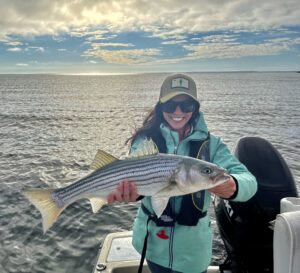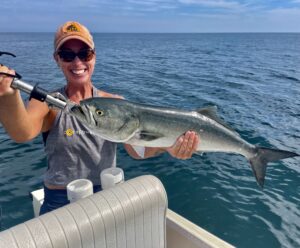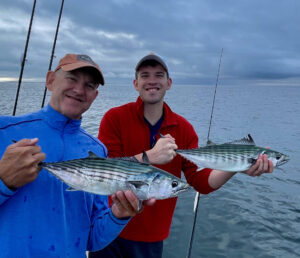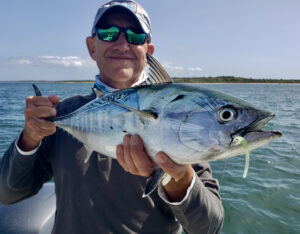Striped Bass
Striped Bass are sometimes called “everyman’s fish.” There’s a lot of truth to that. Stripers can be caught in many ways and in many places. Throughout the season. From boat and shore. Maine to North Carolina. On flies, lures, or bait. In frantic packs, or meandering lazily. They can be ready feeders, or super-finicky. But most of the time, stripers are generally catchable. Challenging, but not so esoteric that you often come home skunked.
The versatility of striped bass means you can fish for them in many ways, depending on what you enjoy. We particularly like to “see the take”. Whether it’s a topwater hit, sight fishing on a flat, or casting at a blitz, we tend to go for a highly visual experience. Any way you catch them, stripers hit hard, fight well, and are a perfect fit for fly rods and light tackle spin. They’re just an enjoyable fish to catch.
We posed a question to each other one day: if your time was up, and you could catch just one more fish – any fish – what would it be, where, and how? Independently, we had the same answer: 30-inch striper, on the flats, 8-weight fly rod, on a gurgler. That would be a great finish.

Bluefish
Bluefish are all attitude. They feed aggressively, hit viciously, and fight like crazy. They’re a blast to catch. And usually not that difficult – if you can find them. Bluefish don’t often sit still. They roam constantly. Ideally, bluefish are somewhere blitzing the surface, and all you have to do is locate the mosh pit and cast into it. But sometimes they’re just “around” but circling below the surface. Making a commotion with a popper or plug can bring them rocketing up out of nowhere to take your offering on the ascent. That can almost be more fun than a blitz.
Bluefish are incredible predators. Their strength always amazes anglers that have never tangled with one before, their eyes seem to focus with demonic intensity, and their teeth… OH man, those teeth. Some anglers view Bluefish with contempt because of their propensity to destroy flies, lures, and leaders, but we love catching them.
Bluefish in our fishery range from 16-inch “snappers” to 36-inch “gators.” Catching snappers is a lot of fun. Catching gators is a blend of thrill and astonishment. How can a fish be so pissed off? Wow.

Bonito
Bonito are like the opening band for the albie show. They arrive earlier than albies, and are almost as good.
Bonito are definitely a different beast than stripers and bluefish. They’re like a cross between a tuna and a mackerel. Long and lean, they utilize their speed to feed – and to put up a fight. To catch a bonito usually takes a quick cast. To land one takes a protracted effort, featuring long blistering runs.
The good news for the angler, and bad news for the bonito, is they’re good to eat – especially raw. We’re pretty strict about our catch-and-release policy. But a fresh sashimied bonito dipped in soy and wasabi is pretty hard to beat.

False Albacore
With Albies, it’s a love-hate-love relationship. They’re such a thrill to see, and challenge to catch, that you always eventually forgive them for their occasional picky behavior.
False Albacore are small football-shaped tunas. They have slick-smooth skin and fins that retract into their body for better hydrodynamics. They’re built for speed. You can catch albies blind-casting, but usually you’re casting at moving fish. Often you get just one shot at a pod. That moment can be exhilarating if you keep your cool and get a good cast off, or humiliating if you panic and make a mess of it, or frustrating if you put it in there and they just won’t eat. Simply making contact is the first challenge.
If you manage to get a hit, the second challenge begins. Once you come tight, albies take off. Sometimes the run is away from the boat, which – on a fly rod – gives you mere seconds to manage your loose line, avoid knots, tangles, and line burns, and get the fish on the reel. Sometimes the run is toward the boat, which means you have to do all of the above AND recover line at a speed that even the best reels aren’t made for. It’s mayhem.
If you get that far, the third challenge begins. The fight has just begun. Albies will run away from you, then run toward you, then they’re under the boat, then they’re running away again. And, for a fish that typically weighs 6-10 lbs., they pull like crazy. Albies will break equipment. It’s that kind of experience.
If you finally bring an albie to the boat, it’s an achievement – especially on fly. It feels great. And they’re a really cool-looking fish. You have your brief moment eye-to-eye, snap a quick pic, send him back to the pack, take a breath, and can’t wait to do it again. It’s that good.
